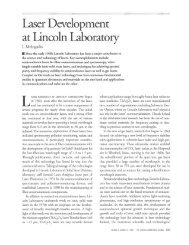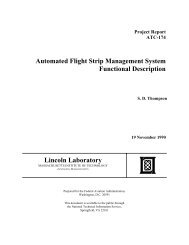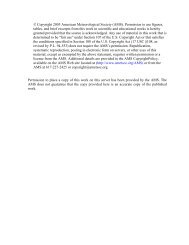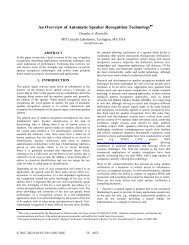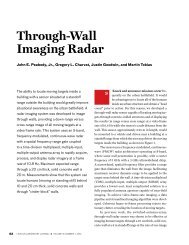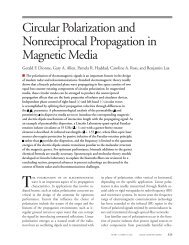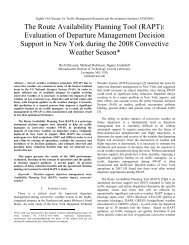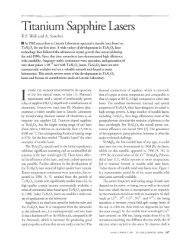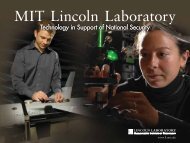2011 Annual Report - MIT Lincoln Laboratory
2011 Annual Report - MIT Lincoln Laboratory
2011 Annual Report - MIT Lincoln Laboratory
You also want an ePaper? Increase the reach of your titles
YUMPU automatically turns print PDFs into web optimized ePapers that Google loves.
■ Under sponsorship of the DHS S&T, the<br />
Container Security Testbed (CSTB) for<br />
maritime cargo security was developed.<br />
The CSTB evaluates technologies for<br />
detecting trace chemical or biological<br />
signatures of hazardous materials.<br />
■ New bio medical initiatives emphasize<br />
medical diagnostics for the DoD and<br />
leverage <strong>Laboratory</strong> strengths in sensing,<br />
sig nal processing, algorithms, and<br />
data communications to develop technologies<br />
at molecular, cellular, and human<br />
system scales.<br />
■ For use in countering chemical threats,<br />
the <strong>Laboratory</strong> developed concepts of<br />
operation, conducted threat phenomenology<br />
measurements to assess military<br />
utility, performed table top exer cises, and<br />
led development of a rapid fielding initiative.<br />
LEADERSHIP<br />
FUTURE OUTLOOK<br />
Dr. Israel Soibelman Mr. James M. Flavin Dr. Timothy J. Dasey<br />
<strong>Lincoln</strong> <strong>Laboratory</strong> is<br />
developing, integrating,<br />
and evaluating microfluidic<br />
systems to enable new<br />
capabilities in biometrics,<br />
forensics, synthetic<br />
biology, and biomedical<br />
applications. Dr. Jeffrey<br />
Palmer is evaluating the<br />
performance of a digital<br />
microfluidic platform<br />
(through a research<br />
collaboration with<br />
Advanced Liquid Logic)<br />
for use in the rapid DNA<br />
analysis program.<br />
■ Securing and defending U.S. borders motivate the need for an integrated air, land, and<br />
maritime architecture. This need will spur advancements in wide-area sensors, such as<br />
over-the-horizon radar, as well as in advanced data fusion and decision support tools.<br />
<strong>Lincoln</strong> <strong>Laboratory</strong> will apply its strengths in advanced sensors, signal processing,<br />
service-oriented architecture, and rapid prototyping to provide these technologies.<br />
■ Analysis, development, and testing of advanced chemical and biological defense<br />
solutions will continue, with strong contributions in countering chemical threats.<br />
■ The <strong>Laboratory</strong> will provide next-generation biometrics and forensics technologies for<br />
theater and homeland security, including different sensing modalities, identification<br />
techniques, and fusion algorithms.<br />
■ In partnership with local, state, and federal operational communities, the <strong>Laboratory</strong><br />
will develop and assess technologies and architectures to address critical infrastructure<br />
protection and disaster response. Solutions will leverage <strong>Laboratory</strong> strengths in<br />
netcentric architecture, sensors, and decision support.<br />
■ Activities with the U.S. Coast Guard will include assessments of sensors, development<br />
of decision support architectures, and evaluation of test beds for port security.<br />
<strong>MIT</strong> <strong>Lincoln</strong> <strong>Laboratory</strong> 41



